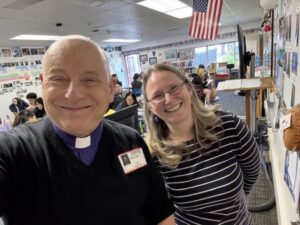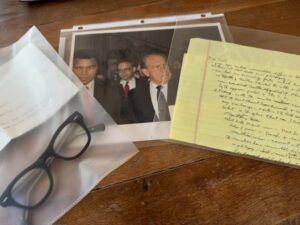“What do you see? What does it mean?” History instructor Heather Moore poses these questions over and over to her students at Arcadia High School. So for the second time in three years, invited to speak to three of her classes about my old boss Richard Nixon and the late 20th century, I brought things to see and talk about, including one of Nixon’s ties and his reading glasses as well as examples of his handwriting.
Ms. Moore — an aluma of Saint Mark’s School in Altadena who was recently named junior warden of Grace Episcopal Church in Glendora, hence our connection — began each class by displaying a cartoon suggesting Nixon will be remembered either for Watergate or his foreign policy successes. I do my best to present both sides. This year, I took care, in consideration of the work of historian Rick Perlstein, to make sure students knew that if he hadn’t been thwarted by Watergate investigators in 1973, Nixon planned a DOGE-like reduction in the size of the federal government. Students asked about Nixon’s temperament (shy, watchful, and prone to paranoia, I said) and wondered if he felt ashamed because of Watergate (yes, profoundly).
 As cosmopolitan as all Southern California, students were especially interested in the foreign policy side of the scale. When I asked if the U.S. was an Atlantic or Pacific power, several quickly said “both.” When I asked if anyone could tell me about Tiananmen Square, a student said her mother had been there in June 1989. From sidebar conversations after the classes, I learned many are watching developments between China and Taiwan carefully. Indeed they were better briefed than the average 16-year-old. We want freedom and justice for all, and diplomacy without war, we all agreed. We want presidents who don’t get so distracted by their Watergates that they don’t get foreign policy right and fail in their responsibility to leave the world safer than they found it.
As cosmopolitan as all Southern California, students were especially interested in the foreign policy side of the scale. When I asked if the U.S. was an Atlantic or Pacific power, several quickly said “both.” When I asked if anyone could tell me about Tiananmen Square, a student said her mother had been there in June 1989. From sidebar conversations after the classes, I learned many are watching developments between China and Taiwan carefully. Indeed they were better briefed than the average 16-year-old. We want freedom and justice for all, and diplomacy without war, we all agreed. We want presidents who don’t get so distracted by their Watergates that they don’t get foreign policy right and fail in their responsibility to leave the world safer than they found it.

